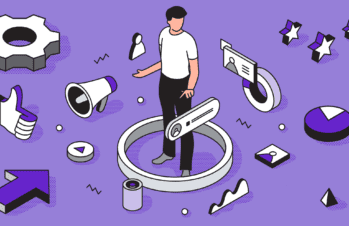What really ticks for today’s savvy buyers? It’s a riddle every marketer is trying to solve.
Sure, value for money is a big deal—who doesn’t love scoring a great product at a great price? But there’s more to the story. Quality, durability, and stellar service also top the charts in the consumer wishlist.
And it’s not just about what they’re buying, but how it’s making a difference. Buyers today are leaning into a greener, more ethical world. Think organic munchies, cars that are kinder to the planet—it’s cool to care, and it’s reshaping shopping lists everywhere.
And, of course, the reputation of a brand plays a significant role in influencing buyer decisions. Trustworthy brands that have built a positive image over time tend to attract more customers. In the era of social media and instant communication, a brand’s image can be bolstered or blemished in the blink of an eye, making brand management more important than ever.
Forrester’s 2023 Global Buyers’ Journey Survey reveals a cautious and complex landscape for B2Bs. Budgets are tight, and every dollar counts. It’s not just about the price tag; it’s about making sure every purchase packs a punch in terms of ROI.
Younger buyers in particular face challenges in building consensus when in charge of vendor selection, indicating a need for solutions that not only offer value, but also simplify decision-making processes. This is because the younger crowd is gaining a foothold in purchasing power, but lacks the authority of older buyers. The pressure to make the right purchasing decisions can enhance their influence in this space.
McKinsey’s B2C findings ring a different tune. B2C consumers oscillate between seeking value and indulging in premium experiences—and looking beyond just the product to its impact on their personal identity and lifestyle. The modern B2C buyer is not only versatile, but also increasingly favors omnichannel shopping experiences, highlighting the importance of a seamless blend of online and offline interactions in consumer marketing.
But these aren’t the only differences in the motivation between B2B and B2C buyers—and each motivating factor plays into how companies market and sell their products.
What motivates B2B buyers?
The core motivator often hinges on avoiding blame. No one wants to be responsible for a decision that turns out poorly, particularly in a professional setting. This aversion influences buying behavior significantly. Businesses are looking for assurances and proof points that what they are investing in will deliver the promised returns and not lead to regrettable mistakes. The B2B sales cycle tends to be risk-averse, with buyers seeking validations, case studies, and guarantees that mitigate the possibility of fault or failure.
Rational Decision-Making Approach
In B2B, purchasing decisions are often grounded in rationality. Businesses seek solutions that offer tangible benefits, like cost savings, productivity enhancements, or competitive advantages. This rational approach means that B2B buyers tend to scrutinize products or services more meticulously compared to the average consumer. They are not just buying a product; they are investing in a solution that needs to align with their business objectives and strategies.
Elaborate Decision-Making Processes
The decision-making process in B2B transactions is typically more complex and prolonged than in B2C settings. This complexity stems from the fact that these decisions often involve significant investments and can have far-reaching implications for the business. As a result, the process usually includes multiple stages—from recognizing a need and exploring solutions, to evaluating options and making the final purchase. Each stage is marked by thorough research and careful consideration, often involving detailed comparisons of features, benefits, and ROI.
Involvement of Buying Groups and Committees
Unlike B2C purchases, which are usually made by individuals or families, B2B buying decisions often involve groups or committees. This can include a variety of stakeholders, such as procurement professionals, department heads, technical experts, and sometimes even top-level executives. The involvement of these diverse stakeholders means that the seller must address a wide range of concerns and preferences, from technical specifications to cost-effectiveness and long-term ROI.
Strategies to Reach B2B Buyers
Addressing Pain Points
Marketers should identify common challenges or problems that your product or service can solve. Effective communication is key here—highlighting how your solution can alleviate their specific issues, improve efficiency, or enhance productivity can be very persuasive. This also means demonstrating how your product or service minimizes the risk of blame. For instance, offering guarantees, warranties, or trial periods can help in assuaging fears of making the wrong decision.
Emphasizing Reliability and Trust
Businesses want to know that they are investing in a reliable solution and a trustworthy partner. This can be achieved by consistently delivering quality products and services, being transparent in your dealings, and showcasing your expertise and industry knowledge. Demonstrating a track record of success, such as highlighting long-standing relationships with other reputable businesses, can significantly bolster your image as a ‘safe choice.’
Another way to build trust and credibility is to leverage internal influencers. When we worked with John Burns Real Estate Consulting (JBREC), we empowered their employees to become active LinkedIn influencers, proving the value of cultivating and leveraging internal influencers to bolster reliability and market presence.
Leveraging internal influencers works because it personalizes and humanizes the brand, demonstrating expertise and thought leadership directly from the company’s team. This approach builds trust and credibility as stakeholders engage with the actual people driving the company’s success, making the business more relatable and reputable in its industry.
Using Data and Testimonials Effectively
Nothing speaks louder than proven results. Leveraging data and testimonials is an effective way to build credibility and showcase the value of your offerings. Data-driven results can provide tangible evidence of your product’s effectiveness, while testimonials and case studies from satisfied customers can offer real-world proof of your solution’s impact. These tools not only demonstrate the benefits of your products or services, but also provide social proof, which is a powerful influencer in B2B decision-making.
What motivates B2C buyers?
Unlike their B2B counterparts, B2C consumers make purchasing decisions that are driven by a desire for personal fulfillment, convenience, or luxury. Their motivations are often tied to seeking personal identity or social validation through their purchases. This might mean buying products that align with their values, enhance their status, or simply bring joy and comfort to their daily lives.
Driven by Immediate Needs and Desires
B2C consumers are typically looking for quick solutions or gratifications. Whether it’s the latest fashion trend or the newest tech gadget, B2C purchases are often driven by what consumers want or need at the moment. These decisions are influenced by a variety of factors, including advertising, peer recommendations, or even a spontaneous desire for something new or different.
Tendency Towards Impulsive Buying
Attractive deals, engaging advertisements, or even the mere placement of products can trigger spontaneous purchase decisions. These impulsive actions are not just about the thrill of acquiring something new; they are also deeply tied to emotional satisfaction and the consumer’s personal identity.
Personal Preferences as a Primary Decision Driver
Personal taste, lifestyle compatibility, and individual identity strongly influence B2C purchases. Consumers look for products and services that not only meet their needs, but also align with their values and reflect their personal style. This emphasis on personal preference means that B2C marketers need to understand and cater to the diverse tastes and lifestyles of their target audience.
Strategies to Reach B2C Buyers
Tapping into Emotions
Effective B2C strategies often involve storytelling that connects with consumers on an emotional level. Whether it’s the joy of discovery, the pride of ownership, or the comfort of reliability, businesses need to craft messages that evoke feelings and forge a personal connection with the consumer.
Quick, Engaging, and Visually Appealing Campaigns
Consumers are bombarded with messages daily, so standing out is key. Quick, engaging, and visually appealing campaigns are more likely to grab attention and make a lasting impression. This means using vibrant images, compelling videos, and concise messaging that convey value quickly and effectively.
Highlighting Personal Benefits and Experiences
Consumers want to know what’s in it for them. Highlighting the personal benefits and experiences that come with a product or service can significantly influence purchasing decisions. Whether it’s convenience, style, status, or health, businesses need to clearly articulate how their offerings enhance the consumer’s lifestyle or solve their problems. Personal testimonials, user reviews, and immersive experiences can all help illustrate these benefits in a tangible and relatable way.
By addressing these core motivations and adapting strategies accordingly, businesses can better connect with their target audiences, foster lasting relationships, and drive successful outcomes in their respective markets. Ready to find out exactly what motivates your buyers and how to reach them? Reach out to us today.







